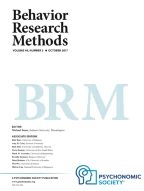Abstract
Investigation of cognitive processes and visual attention during problem-solving tasks is an important part of understanding human reasoning. Eyetracking technology has proven to have many benefits in revealing visual attention patterns. However, the high price of accurate eyetrackers and the difficulties associated with using them represent major obstacles to their wider application. Therefore, previous studies have sought to find alternatives to eyetracking. The Restricted Focus Viewer (RFV) brings a small part of an otherwise blurred display to the focus of visual attention: A user controls what part of the screen is in focus by using a computer mouse and explicitly selecting the area to be shown in focus. Recently, some studies have employed the RFV to investigate cognitive behavior of users, and some researchers have even enhanced the tool to study usability. We replicated a previous RFV-based study while also recording gaze data. We compared the attention allocation in time and space as reported by the RFV and an eyetracker. Further, we investigated the effects of RFV’s display blurring on the visual attention allocation of 18 novice and expert programmers. Our results indicate that the data obtained from the two tools differ. Also, the RFV-blurring interferes with the strategies utilized by experts, and has an effect on fixation duration. However, task performance was preserved.
Article PDF
Similar content being viewed by others
Avoid common mistakes on your manuscript.
References
Bednarik, R., Myller, N., Sutinen, E., &Tukiainen, M. (2005). Effects of experience on gaze behavior during program animation. In P. Romero, J. Good, E. Acosta Chaparro, & S. Bryant (Eds.),Proceedings of the 17th Annual Workshop of the Psychology of Programming Interest Group (PPIG ’05) (pp. 49–61). Brighton, U.K.: University of Sussex.
Bednarik, R., &Tukiainen, M. (2004). Visual attention and representation switching in Java program debugging: A study using eye movement tracking. In E. Dunican & T. R. G. Green (Eds.),Proceedings of the 16th Annual Workshop of the Psychology of Programming Interest Group (PPIG ’04) (pp. 159–169). Carlow, Ireland: Institute of Technology.
Fix, V., Wiedenbeck, S., &Scholtz, J. (1993). Mental representations of programs by novices and experts.Proceedings of the SIGCHI Conference on Human Factors in Computing Systems (CHI ’93) (pp. 74–79). New York: ACM Press.
Futrelle, R. P., &Rumshisky, A. (2001). Discourse structure of text-graphics documents.Proceedings of the 1st International Symposium on Smart Graphics. Hawthorne, New York: ACM Press.
Goldberg, J. H., &Kotval, X. P. (1998). Eye movement-based evaluation of the computer interface. In S. K. Kumar (Ed.),Advances in occupational ergonomics and safety (pp. 529–532). Amsterdam: IOS Press.
Gugerty, L., &Olson, G. M. (1986). Comprehension differences in debugging by skilled and novice programmers. In E. Soloway & S. Iyengar (Eds.),Empirical studies of programmers: First workshop (pp. 13–27). Norwood, NJ: Ablex.
Hyönä, J., Lorch, R. F., Jr., &Kaakinen, J. K. (2002). Individual differences in reading to summarize expository text: Evidence from eye fixation patterns.Journal of Educational Psychology,94, 44–55.
Jansen, A. R., Blackwell, A. F., &Marriott, K. (2003). A tool for tracking visual attention: The Restricted Focus Viewer.Behavior Research Methods, Instruments, & Computers,35, 57–69.
Jones, M. N., &Mewhort, D. J. K. (2004). Tracking attention with the focus-window technique: The information filter must be calibrated.Behavior Research Methods, Instruments, & Computers,36, 270–276.
Just, M. A., &Carpenter, P. A. (1976). Eye fixations and cognitive processes.Cognitive Psychology,8, 441–480.
Koenemann, J., &Robertson, S. P. (1991). Expert problem solving strategies for program comprehension. In S. P. Robertson, G. M. Olson, & J. S. Olson (Eds.),Proceedings of the SIGCHI Conference on Human Factors in Computing Systems: Reaching through technology (pp. 125–130). New York: ACM Press.
Law, B., Atkins, M. S., Kirkpatrick, A. E., &Lomax, A. J. (2004). Eye gaze patterns differentiate novice and experts in a virtual laparoscopic surgery training environment.Proceedings of the 2004 Symposium on Eye Tracking Research and Applications (pp. 41–48). New York: ACM Press.
Rayner, K. (1998). Eye movements in reading and information processing: 20 years of research.Psychological Bulletin,124, 372–422.
Romero, P., Cox, R., du Boulay, B., &Lutz, R. (2002). Visual attention and representation switching during Java program debugging: A study using the Restricted Focus Viewer. InDiagrammatic Representation and Inference: Second International Conference, Diagrams 2002, Callaway Gardens, GA, USA. April 18–20, 2002: Proceedings (Lecture Notes in Computer Science, Vol. 2317, pp. 221–235). Berlin: Springer.
Romero, P., du Boulay, B., Cox, R., & Lutz, R. (2003). Java debugging strategies in multi-representational environments. In M. Petre (Ed.),Proceedings of the 15th Annual Workshop of the Psychology of Programming Interest Group (PPIG ’03) (pp. 421–434).
Romero, P., du Boulay, B., Lutz, R., &Cox, R. (2003). The effects of graphical and textual visualisations in multi-representational debugging environments. In J. Hosking & P. Cox (Eds.),Proceedings of the 2003 IEEE Symposia on Human Centric Computing Languages and Environments (pp. 236–238). Piscataway, NJ: IEEE Computer Society.
Romero, P., Lutz, R., Cox, R., &du Boulay, B. (2002). Coordination of multiple external representations during Java program debugging. In S. Wiedenbeck & M. Petre (Eds.),Proceedings of the 2002 IEEE Symposia on Human Centric Computing Languages and Environments (pp. 207–214). Piscataway, NJ: IEEE Computer Society.
Sibert, L. E., &Jacob, R. J. K. (2000). Evaluation of eye gaze interaction.Proceedings of the SIGCHI Conference on Human Factors in Computing Systems (pp. 281–288). New York: ACM Press.
Tarasewich, P., &Fillion, S. (2004). Discount eye tracking: The Enhanced Restricted Focus Viewer.Proceedings of the 10th Americas Conference on Information Systems (pp. 1–9). New York: AMCIS.
Vessey, I. (1985). Expertise in debugging computer programs: A process analysis.International Journal of Man-Machine Studies,23, 459–494.
Ware, C., &Mikaelian, H. H. (1987). An evaluation of an eye tracker as a device for computer input.Proceedings of the SIGCHI/GI Conference on Human Factors in Computing Systems and Graphics Interface (CHI ’87) (pp. 183–188). New York: ACM Press.
Author information
Authors and Affiliations
Corresponding author
Additional information
This work was supported by a grant from the Faculty of Science, University of Joensuu.
Rights and permissions
About this article
Cite this article
Bednarik, R., Tukiainen, M. Validating the Restricted Focus Viewer: A study using eye-movement tracking. Behavior Research Methods 39, 274–282 (2007). https://doi.org/10.3758/BF03193158
Received:
Accepted:
Issue Date:
DOI: https://doi.org/10.3758/BF03193158
